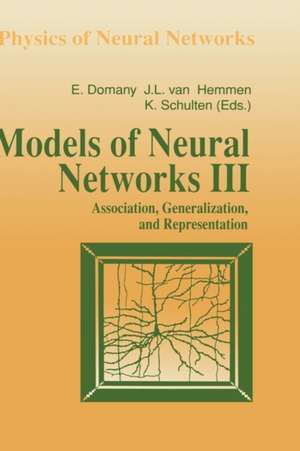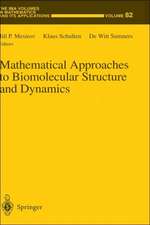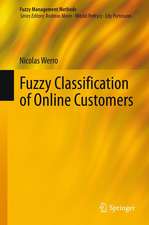Models of Neural Networks III: Association, Generalization, and Representation: Physics of Neural Networks
Editat de Eytan Domany, J. Leo van Hemmen, Klaus Schultenen Limba Engleză Hardback – dec 1995
| Toate formatele și edițiile | Preț | Express |
|---|---|---|
| Paperback (1) | 641.85 lei 6-8 săpt. | |
| Springer – 28 sep 2012 | 641.85 lei 6-8 săpt. | |
| Hardback (1) | 648.24 lei 6-8 săpt. | |
| Springer – dec 1995 | 648.24 lei 6-8 săpt. |
Preț: 648.24 lei
Preț vechi: 762.64 lei
-15% Nou
Puncte Express: 972
Preț estimativ în valută:
124.05€ • 134.71$ • 104.21£
124.05€ • 134.71$ • 104.21£
Carte tipărită la comandă
Livrare economică 22 aprilie-06 mai
Preluare comenzi: 021 569.72.76
Specificații
ISBN-13: 9780387943688
ISBN-10: 0387943684
Pagini: 311
Ilustrații: XIII, 311 p.
Dimensiuni: 155 x 235 x 19 mm
Greutate: 0.64 kg
Ediția:1996
Editura: Springer
Colecția Springer
Seria Physics of Neural Networks
Locul publicării:New York, NY, United States
ISBN-10: 0387943684
Pagini: 311
Ilustrații: XIII, 311 p.
Dimensiuni: 155 x 235 x 19 mm
Greutate: 0.64 kg
Ediția:1996
Editura: Springer
Colecția Springer
Seria Physics of Neural Networks
Locul publicării:New York, NY, United States
Public țintă
Professional/practitionerCuprins
1. Global Analysis of Recurrent Neural Networks.- 1.1 Global Analysis-Why?.- 1.2 A Framework for Neural Dynamics.- 1.3 Fixed Points.- 1.4 Periodic Limit Cycles and Beyond.- 1.5 Synchronization of Action Potentials.- 1.6 Conclusions.- References.- 2. Receptive Fields and Maps in the Visual Cortex: Models of Ocular Dominance and Orientation Columns.- 2.1 Introduction.- 2.2 Correlation-Based Models.- 2.3 The Problem of Map Structure.- 2.4 The Computational Significance of Correlatin-Based Rules.- 2.5 Open Questions.- References.- 3. Associative Data Storage and Retrieval in Neural Networks.- 3.1 Introduction and Overview.- 3.1.1 Memory and Representation.- 3.2 Neural Associatve Memory Models.- 3.3 Analysis of the Retrieval Process.- 3.4 Information Theory of the Memory Process.- 3.5 Model Performance.- 3.6 Discussion.- Appendix 3.1.- Appendix 3.2.- References.- 4. Inferences Modeled with Neural Networks.- 4.1 Introduction.- 4.2 Model for Cognitive Systems and for Experiences.- 4.3 Inductive Inference.- 4.4 External Memory.- 4.5 Limited Use of External Memory.- 4.6 Deductive Inference.- 4.7 Conclusion.- References.- 5. Statistical Mechanics of Generalization.- 5.1 Introduction.- 5.2 General Results.- 5.3 The Perceptron.- 5.4 Geometry in Phase Space and Asymptotic Scaling.- 5.5 Applications to Perceptrons.- 5.6 Summary and Outlook.- Appendix 5.1: Proof of Sauer’s Lemma.- Appendix 5.2: Order Parameters for ADALINE.- References.- 6. Bayesian Methods for Backpropagation Networks.- 6.1 Probability Theory and Occam’s Razor.- 6.2 Neural Networks as Probabilistic Models.- 6.3 Setting Regularization Constants ? and ?.- 6.4 Model Comparison.- 6.5 Error Bars and Predictions.- 6.6 Pruning.- 6.7 Automatic Relevance Determination.- 6.8 Implicit Priors.- 6.9 Cheap and CheerfulImplementations.- 6.10 Discussion.- References.- 7. Penacée: A Neural Net System for Recognizing On-Line Handwriting.- 7.1 Introduction.- 7.2 Description of the Building Blocks.- 7.3 Applications.- 7.4 Conclusion.- References.- 8. Topology Representing Network in Robotics.- 8.1 Introduction.- 8.2 Problem Description.- 8.3 Topology Representing Network Algorithm.- 8.4 Experimental Results and Discussion.- References.































